Abstract
Saline-alkali stress is a major environmental stress affecting the growth and development of plants such as Sorbus pohuashanensis. Although ethylene plays a crucial role in plant response to saline-alkaline stress, its mechanism remains elusive. The mechanism of action of ethylene (ETH) may be related to the accumulation of hormones, reactive oxygen species (ROS), and reactive nitrogen species (RNS). Ethephon is the exogenous ethylene donor. Therefore, for the present study we initially used different concentrations of ethephon (ETH) to treat S. pohuashanensis embryos and identified the best treatment concentration and method to promote the release of dormancy and the germination of S. pohuashanensis embryos. We then analyzed the physiological indexes, including endogenous hormones, ROS, antioxidant components, and reactive nitrogen, in embryos and seedlings to elucidate the mechanism via which ETH manages stress. The analysis showed that 45 mg/L was the best concentration of ETH to relieve the embryo dormancy. ETH at this concentration improved the germination of S. pohuashanensis by 183.21% under saline-alkaline stress; it also improved the germination index and germination potential of the embryos. Further analysis revealed that ETH treatment increased the levels of 1-aminocyclopropane-1-carboxylic acid (ACC), gibberellin (GA), soluble protein, nitric oxide (NO), and glutathione (GSH); increased the activities of superoxide dismutase (SOD), peroxidase (POD), catalase (CAT), nitrate reductase (NR), and nitric oxide synthase (NOS); and decreased the levels of abscisic acid (ABA), hydrogen peroxide (H2O2), superoxide anion, and malondialdehyde (MDA) of S. pohuashanensis under saline-alkali stress. These results indicate that ETH mitigates the inhibitory effects of saline-alkali stress and provides a theoretical basis by which to establish precise control techniques for the release of seed dormancy of tree species.
1. Introduction
Saline-alkali stress, one of the most common abiotic stresses, affects various plant growth and development processes, from seed germination to flowering and fruiting. This stress lowers and delays germination, causes high seedling mortality, and decreases chlorophyll content and photosynthetic performance [1]. Under saline-alkaline stress, seeds absorb less water, limiting proteolytic enzyme activity, restricting respiration, and reducing germination [2,3]. In plants, ethylene is an important hormone and signal substance that participates in many physiological and biochemical processes related to growth and development. It is also involved in plant response to biotic and abiotic stresses [4].
Saline-alkali stress reduces plant biomass by affecting plant photosynthesis, enzyme activity, and stomatal opening [5]. Under sodium bicarbonate (NaHCO3) stress, wheat has been found to accumulate malic acid by upregulating malate dehydrogenase (MDH) and downregulating malate enzyme and tricarboxylic acid (TCA) as part of a cycle involved in coping with alkaline stress [6]. Similarly, cotton regulated the secondary metabolite pathway to maintain ion homeostasis and promote tolerance to NaHCO3 stress [7]. Studies have demonstrated that exogenous ethylene effectively mitigates the inhibitory effects of salt stress on seed germination; however, the underlying regulatory mechanism remains unclear [8].
Sorbus pohuashanensis is a deciduous tree belonging to Maloideae, a member of the Rosaceae subfamily. It is a tree species with high ornamental, medicinal, and edible values [9]. However, the wild S. pohuashanensis population is less dense and sensitive to interspecific competition, which results in poor natural regeneration [10,11,12]. Furthermore, the overexploitation of Sorbus, with immense ornamental value, has caused severe damage to the wild resources in the forests of northeastern China; consequently, the population has been endangered in certain areas.
Previous studies have demonstrated that ethephon (ETH), the ethylene donor, significantly improved the germination percentage, index, and potential of S. pohuashanensis embryos [13]. Additionally, nitric oxide (NO) has been shown to alleviate S. pohuashanensis embryo dormancy, which was closely related to ethylene biosynthesis and abscisic acid (ABA) catabolism [14]. Spraying exogenous ethylene mitigated the inhibitory effect of salt stress on seed germination effectively [15]. In Arabidopsis, excessive endogenous ethylene synthesis and ACC (1-amino-cyclopropane-1-carboxylic acid) treatment reduced salt stress-induced inhibition of seed germination. Typically, ethylene synthesis could be regulated by targeting ACC synthase (ACS) and ACC oxidase (ACO), which are closely related to these hormones. They together regulate the signal transduction and physiological processes of ethylene. Numerous studies have also reported that exogenous ethylene help plants cope with salt stress by regulating the synthesis and removal of reactive oxygen species (ROS) [8]. Though ROS accumulation breaks dormancy and seed germination in certain species [16,17], conditions such as salinity and alkalinity lead to a sharp increase in the production rate of ROS, resulting in oxidative stress [18]. In, hydrogen peroxide (H2O2), a representative ROS was accumulated more in germinating seeds under saline-alkaline conditions than in non-saline-alkaline states, significantly delaying germination [19].
Thus the present study, in which we initially treated S. pohuashanensis embryos with ETH at different concentrations to find the optimal concentration and the method to promote seed dormancy release and germination. We further assessed the effect of exogenous ethylene (ETH) on the germination of S. pohuashanensis embryos under saline-alkali stress by analyzing the physiological indexes, including endogenous hormones, ROS, and active nitrogen, in the embryos and seedlings. The results of these assays will help elucidate the mechanism via which ethylene alleviates the dormancy of S. pohuashanensis embryos under saline-alkali stress. The study will also provide novel insights into the role of exogenous ethylene in promoting the germination of S. pohuashanensis embryos.
2. Results
2.1. Effects of ETH and NaHCO3 on Germination of S. pohuashanensis Embryos
The present study initially examined the effect of different concentrations of ethephon, the ethylene donor, on the germination of S. pohuashanensis embryos. The exogenous addition of ETH significantly increased the germination percentage of S. pohuashanensis embryos (Figure 1). Treatment with different concentrations of ETH (30, 45, and 60 mg/L) significantly improved the germination percentages of S. pohuashanensis (Figure 1). Among the various concentrations, 45 mg/L of ETH resulted in the highest germination of S. pohuashanensis embryos (60%), which was significantly higher than that under no ETH treatment (Figure 1).
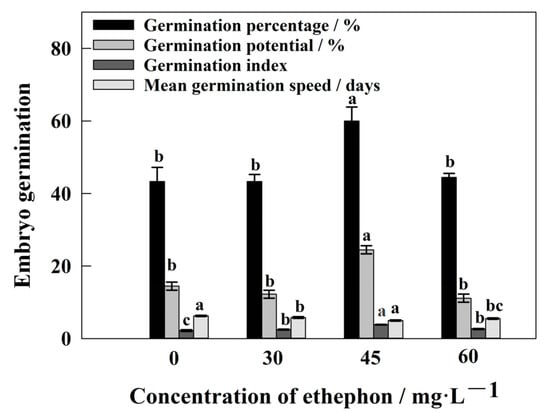
Figure 1.
Effect of different concentrations of ethephon on embryo germination of S. pohuashanensis; data include mean values ± SE (n = 3); letters indicate significant differences at p = 0.05.
Germination of S. pohuashanensis embryos was severely impaired under salt stress. Here, S. pohuashanensis seeds showed only a 6.67% germination percentage when treated with NaHCO3. Meanwhile, the percentage of germination in control and ETH treatments was 84.6% and 88.9%, respectively, which were significantly higher than the NaHCO3 treatment (p ≤ 0.05, Table 1). Further, to analyze the role of ETH in regulating the inhibitory effects of the saline-alkali environment, we treated the seeds with a mixture of ETH and NaHCO3. The results show that the embryo germination percentage increased by a generally lower amount than the ETH and NaHCO3 treatment when compared with NaHCO3 alone. Similar results were also observed for germination index and germination potential (Table 1). These results indicate that ETH reduced the inhibitory effects of saline-alkali stress on the germination of S. pohuashanensis embryos (Figure 2).

Table 1.
Effect of saline-alkali stress and ethephon treatment on the germination indexes of S. pohuashanensis embryos. Here, 45 mg/mL ETH was used. Data presented are mean values of three independent experiments; different lowercase letters indicate significant differences at the p = 0.05 level.
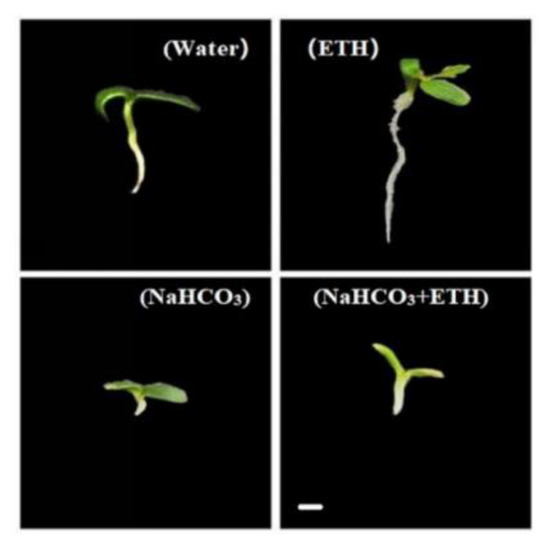
Figure 2.
Growth of seedlings on day 8 under various treatments. (Bar = 1.0 mm).
2.2. Changes in Hormone Content of Embryos during Germination in S. pohuashanensis
As the exogenous addition of ETH and NaHCO3 showed a difference in the germination percentage of S. pohuashanensis embryos, we further analyzed the hormone content of the seeds under various treatments during germination, daily, for eight days (Figure 3). The ACC content of embryos increased from day 1 to 8 under all treatments. Under the ETH treatment, the ACC content first increased, followed by a slight decrease, and then an increase (Figure 3A). On day 8, the content of ACC in seeds treated with ETH was significantly higher than that under the other treatments (Figure 3A). After the addition of ETH to NaHCO3, the release of ACC significantly increased. These results indicate that the exogenous addition of ETH promoted the release of ACC in embryos under NaHCO3 stress. Similarly, the ABA content also increased with time during the release of dormancy and germination of seeds under all treatments (Figure 3B). The ABA content of the seeds was in the following order: NaHCO3 > NaHCO3 + ETH > CK > ETH (Figure 3B; p). Furthermore, ETH treatment significantly increased the GA content in the embryos (Figure 3C). In the early stage of germination, the differences in GA content of seeds among the treatments were insignificant. By day 8, ETH alone resulted in high GA content, while NaHCO3 resulted in a low GA content; however, ETH added to NaHCO3 resulted in high GA content (Figure 3C).
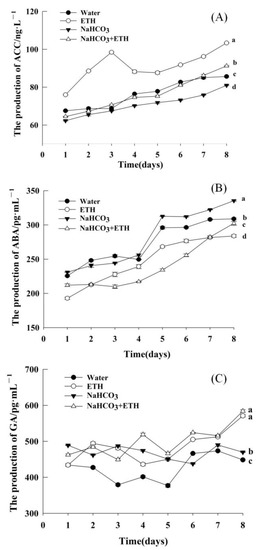
Figure 3.
Endogenous hormone content of S. pohuashanensis embryos during germination. (A) 1-aminocyclopropane-1-carboxylic acid (ACC); (B) abscisic acid (ABA); (C) gibberellin (GA). Data presented are mean values ± SE (n = 3); different lowercase letters indicate significant differences at p = 0.05 on day 8.
2.3. Changes in ROS during Germination of S. pohuashanensis Embryos
Further, to study the effects of ETH on ROS during embryo germination of S. pohuashanensis under NaHCO3 stress, we evaluated the changes in peroxide (H2O2), superoxide anion, and malondialdehyde (MDA) content (Figure 4). During the late germination stage, control and ETH-treated seeds had almost similar H2O2 levels; NaHCO3 treatment significantly triggered the accumulation of H2O2, while the presence of ETH under NaHCO3 stress reduced the accumulation of H2O2 (Figure 4A). This proved that the combination of both treatments showed an antagonistic effect, which significantly reduced the H2O2 content in the embryos.
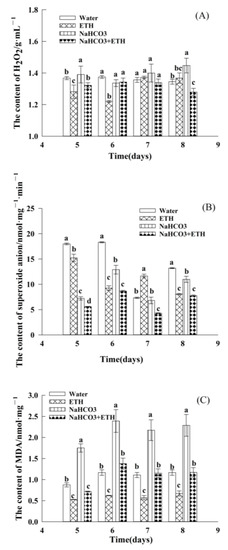
Figure 4.
ROS-related indicators in the seedlings of S. pohuashanensis from day 5 to 8 of germination. (A) Hydrogen peroxide (H2O2); (B) superoxide anion; (C) malondialdehyde (MDA). Data presented are mean values ± SE (n = 3); different lowercase letters indicate significant differences at p = 0.05 on day 8.
Furthermore, all treatments reduced the superoxide anion content during the middle and late stages of embryo germination (Figure 4B). The superoxide anion content of S. pohuashanensis embryos treated with NaHCO3 was significantly higher compared with those under ETH alone and in combination with NaHCO3. This observation indicates that adding ETH did not improve the superoxide anion content of S. pohuashanensis embryos subjected to NaHCO3. In addition, treatment with ETH alone resulted in lower MDA levels than the control, while NaHCO3 treatment resulted in high MDA levels (Figure 4C). However, ETH added to NaHCO3 reduced the MDA content of the embryos by 48.68%.
2.4. Changes in Antioxidant Enzyme Activities during Germination of S. pohuashanensis Embryos
We further determined the levels of SOD, CAT, POD, soluble protein, and GSH to assess the effect of exogenous ETH and NaHCO3 on the antioxidant system during the germination of S. pohuashanensis embryos. Seedlings under NaHCO3 stress showed lower SOD, CAT, and POD activities, soluble proteins, and GSH content than the other treatments (Figure 5).
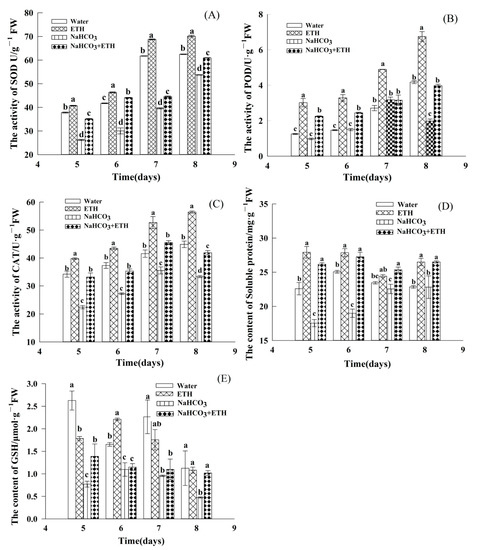
Figure 5.
Levels of antioxidant enzymes and related indicators in the seedlings of S. pohuashanensis from day 5 to 8 of germination. (A) Superoxide dismutase (SOD); (B) peroxidase (POD); (C) catalase (CAT); (D) soluble protein; (E) glutathione (GSH). Data presented are mean values ± SE (n = 3); different lowercase letters indicate significant differences at p = 0.05 for day 8.
The SOD activity of S. pohuashanensis embryos gradually increased with the release of embryo dormancy and germination. The SOD levels in embryos treated with ETH were consistently higher than those under control (CK), while those under NaHCO3 + ETH treatment were higher than those under NaHCO3 alone (Figure 5A). The POD activity in the embryos treated with NaHCO3 increased initially and then decreased, while that in the embryos under other treatments showed a gradual increase (Figure 5B). The addition of ETH increased POD activity by 56.44% compared with the control (Figure 5B). Furthermore, the addition of ETH to NaHCO3 resulted in a 50.25% increase in embryonic POD activity. ETH-treated S. pohuashanensis embryos showed a gradual increase in CAT activity (Figure 5C), while the NaHCO3 and NaHCO3 + ETH treatments showed an increase initially and then a decrease. The embryos under NaHCO3 stress had CAT levels lower than the control; however, the addition of ETH to NaHCO3 resulted in a significant increase in the CAT activity compared with those under NaHCO3 treatment alone (Figure 5C).
The soluble protein content of the S. pohuashanensis embryos treated with ETH increased. The ETH treatment increased the soluble protein content of embryos compared with the control, while NaHCO3 decreased. Furthermore, the addition of ETH to NaHCO3 increased the soluble protein content of embryos by 49.17% (Figure 5D). At the start of germination, the soluble protein content of treatment with ETH showed 1.79 μmol/g FW, which was significantly reduced to 0.77 μmol/g FW under NaHCO3 treatment. Further, there was an 80.52% increase in the glutathione (GSH) content of the embryos when ETH was added to NaHCO3 (Figure 5E). During the late germination stage (eighth day), the GSH content of S. pohuashanensis embryos treated with NaHCO3 was the lowest (0.46 μmol/g FW).
2.5. Changes in Active Nitrogen Content during Germination of S. pohuashanensis Embryos
The NO content in the embryos of S. pohuashanensis showed an overall increase towards the late germination stage. NO content in the ETH-treated embryos was the highest, while that under NaHCO3 was the lowest (Figure 6A). After the addition of ETH to NaHCO3, the NO content of the embryos gradually increased by 23.84% (Figure 6A).
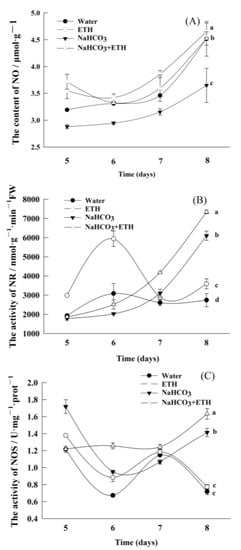
Figure 6.
Levels of active nitrogen-related indicators in the seedlings of S. pohuashanensis from day 5 to 8 of embryo germination. (A) Nitric oxide (NO); (B) nitrate reductase (NR); (C) nitric oxide synthase (NOS). Data presented are mean values ± SE (n = 3); different lowercase letters indicate significant differences at p = 0.05 on day 8.
We further analyzed the activity of NR and NOS associated with the conversion of nitrate–nitrogen to ammonia–nitrogen in plants. The NR activity of S. pohuashanensis embryos after NaHCO3 treatment and the NaHCO3 and ETH combined treatment gradually increased with time (Figure 6B). The NR activity of ETH-treated embryos was significantly higher than CK. The addition of ETH to NaHCO3 resulted in a 20.29% increase in embryonic NR activity (Figure 6B). In addition, the ETH-treated embryos showed increased NOS activity (Figure 6C). The addition of ETH to NaHCO3 resulted in a 15.60% increase in embryonic NOS activity (Figure 6C).
3. Discussion
Excessive salinity inhibits plant growth, leading to diminished yield and even death [20]. Seed germination percentage is an important index for identifying the saline-alkaline tolerance of plant species [21] and ETH treatment showed a better effect on seed germination under salt stress [22]. Similarly, in this study, ETH significantly promoted the germination of S. pohuashanensis embryos, which NaHCO3 inhibited. These observations indicate that ETH significantly alleviated the inhibitory effects of NaHCO3 on S. pohuashanensis embryos. However, ETH promoted embryo germination at 45 mg/L but not at 30 mg/mL and 60 mg/mL concentrations. These observations suggest 45 mg/mL to be the optimal concentration for promoting germination in S. pohuashanensis. NO has also demonstrated a similar concentration-dependent effect on embryo germination in S. pohuashanensis [23]. Low concentrations of NO promoted S. pohuashanensis embryo germination, while high concentrations inhibited it [23].
In plants, multiple hormones regulate the process of seed germination. Among these phytohormones, ETH regulates salt tolerance by inducing several protective mechanisms [24,25] or enhancing antioxidant systems by increasing nutrient accumulation [26]. Typically, ACC, GA, and ABA are the hormones involved in germination, and the addition of exogenous ETH dramatically increases the release of endogenous ETH [15]. ACC may function as a novel signaling molecule [27]. In this study, ACC was produced continuously with progress in germination under ETH treatment, while the lowest amount of ACC was produced in NaHCO3-treated S. pohuashanensis embryos. This observation suggests that salt stress could enhance ETH production by increasing the enzyme activity of the ETH biosynthetic pathway [28]. In plants, ABA gets significantly upregulated under salt stress and positively regulates plant responses to stress [29]. Our study found that the endogenous ABA content was lower with the addition of exogenous ETH, while it was always higher under salt stress. This observation indicates the positive role of ABA in regulating the response to salt stress. With the effect of ETH on ABA being opposite, a possible mutual inhibition between ETH and ABA was speculated. Thus, ETH slowed down the embryo’s response to salt stress by reducing the accumulation of ABA, thereby promoting the germination of embryos. In plants, GA is an endogenous signaling molecule breaking seed dormancy. Many studies have demonstrated the antagonistic effect of ABA on GA, thereby inhibiting seed germination [29]. Studies have showed that GA3 content decreased with salt stress [30]. In this study, the GA content of S. pohuashanensis embryos treated with NaHCO3 was significantly lower than those under ETH and ETH + NaHCO3 treatments, consistent with previous findings. Meanwhile, ETH alleviated the effects of salt stress on seed germination against seedling growth.
Salt stress severely affects the balance of free radicals in plant cells, leading to the accumulation of ROS, peroxidation of cell membranes, and damage to cell structure [31]. Germination of seeds cannot be uncoupled from the accumulation of ROS either under normal or stress conditions. However, H2O2 accumulates in seeds under salt stress and exacerbates membrane injury, leading to poor seed germination and even death [32]. In this study, NaHCO3 treatment caused significant H2O2 accumulation, whereas treatment with ETH alleviated H2O2 accumulation in S. pohuashanensis embryos under salt stress.
Antioxidant enzymes and antioxidants, the key factors in ROS detoxification, maintain cellular redox homeostasis within their physiological limits [33]. Under saline-alkaline stress, CAT and SOD play essential roles in defense against oxidative damage and regulate the mutual coordination of antioxidant enzymes to eliminate intracellular ROS. In this study, ETH treatment increased the content or activities of various antioxidant enzymes in the embryos of S. pohuashanensis but reduced the accumulation of MDA and H2O2. They also increased the activity of POD, consistent with earlier findings [15]. A decrease in oxidative stress observed in salt-stressed plants after ETH treatment might be due to increased antioxidant enzyme activities, proline and glutathione content, and redox status. However, Ozt€urk and Demir have reported that ETH decreases POD activity under salt stress [34]. GSH is an important antioxidant that contributes to abiotic stress tolerance; it maintains an intracellular reduced redox environment by metabolizing various ROS and their reaction products. Excess ETH produced by ETH under salt stress was minimized in the optimal range, which favorably regulated GSH production by controlling the enzymatic activity of the ascorbate glutathione cycle [35]. Thus, the study showed that saline-alkaline stress adversely affected the activities of antioxidant enzymes in seedlings; their activities decreased with the severity of stress [31]. However, under saline-alkaline stress, ETH alleviated the germination inhibitory effects by increasing the antioxidant enzyme levels and regulating ROS production.
In addition, saline-alkaline conditions decreased the amount of NO in S. pohuashanensis embryos. Meanwhile, the NO amount increased by 23.84% under NaHCO3 + ETH treatment compared with NaHCO3 treatment. This observation suggests that the germination of S. pohuashanensis seeds depends on the action of classical phytohormones, such as GA, and the regulation of signaling molecules, such as NO [36]. In Arabidopsis and apple embryos, NO was found to break seed dormancy and stimulate germination by inducing ETH biosynthesis [16,37,38,39]. Similar results have been demonstrated in the embryos of S. pohuashanensis [14]. NR is one of the sources of NO signaling molecules in plants, and enhanced NR activity suggests that ethylene glycol promotion of rowan embryo germination may be closely related to nitric oxide signaling because NR is a source of intracellular nitric oxide signaling molecule production [14]. In S. pohuashanensis embryos, the germination percentage was significantly higher in the embryos under ETH treatment compared with those under CK treatment; here, the activities of NO, NR, and NOS were also higher in the CK treatment compared with the saline-alkaline environment. This finding implies that RNS positively regulated the exogenous ethylene-mediated promotion of embryo germination in S. pohuashanensis.
4. Materials and Methods
4.1. Experimental Materials
Mature berries of adult S. pohuashanensis plants were collected from the Maoershan Forest Research Station of Northeast Forestry University, Heilongjiang, China (127°30′–127°34′ E, 45°21′–45°25′ N) in early October 2020. Then, mature and infection-free seeds (9–10% water content) were collected from these berries, placed in sealed plastic bags, and stored in the refrigerator at 4 °C for further analysis.
4.2. Experimental Methods
4.2.1. Seed Pre-Treatment
Dormant seeds of uniform texture with an average weight of 2.04 mg, an average moisture content of 5.79%, and an average viability of 88.89% were selected, soaked in distilled water at 20 ± 5 °C for 48 h and 0.2% (v/v) NaClO solution for 10–15 min, and finally rinsed with water. The coat of these disinfected seeds was stripped on ice (to avoid enzyme inactivation), and the peeled embryos were used for the subsequent experiments [14]. The embryo obtained after pre-treatment is shown in Figure 7.
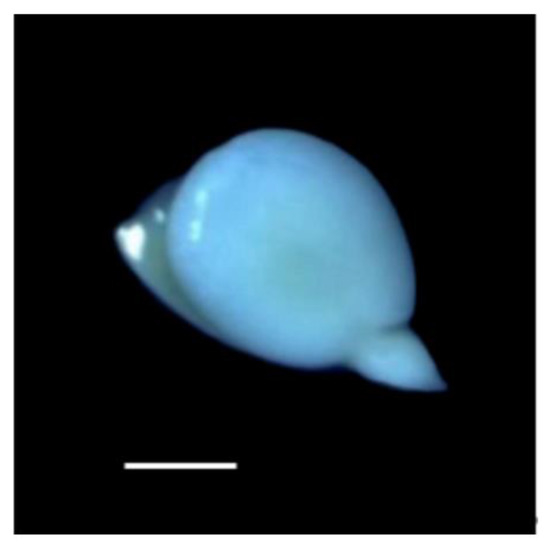
Figure 7.
Embryo of S. pohuashanensis with seed coat removed (Bar = 1.0 mm).
4.2.2. Ethephon Treatment
Initially, the embryos of S. pohuashanensis were treated with different concentrations of ethephon (30, 45, and 60 mg/L; Shanghai Huayuan Chemical Industry, Shanghai, China). Approximately 3 mL of the prepared ETH solution was added to wet the filter paper in a petri dish. The concentration that resulted in the highest germination percentage (45 mg/L) was selected for further analysis.
4.2.3. Seed Germination under Salt Stress
NaHCO3 (Tianjin third factory) was chosen to simulate a saline-alkaline stress environment for S. pohuashanensis in this study. The test concentration was determined based on approximately 0.15% soluble salt (Na+) content present in the saline-alkaline soil surface after the end of the test (concentration of 18 mmol/L; EC = 0; pH = 9.7). NaHCO3 and ETH to treat seeds were prepared at a mass ratio of 30:1.
4.2.4. Germination Experiments
The embryos of S. pohuashanensis were treated with distilled water, ethephon, NaHCO3, or a mixture of NaHCO3 and ethephon. Two layers of filter paper were placed in Petri dishes with a diameter of 9 cm [40]. Three microliters of one of the above solutions were added to moisten the filter paper, and the embryos were placed on the filter paper at the rate of 30 embryos per Petri dish. These seeds were incubated at 25 °C under 60 μmol·m−2·s−1 light (16 h per day) to allow germination. Sterile water was sprayed on the culture dish every 24 h till the end of the germination test to maintain humidity. At least three replicates were maintained per treatment. The germination indexes were calculated using the following equations:
where D represents the number of days from embryo placement, and n indicates the number of germinating embryos on each corresponding day.
where Gt indicates the number of germinations on the day, and Dt indicates the number of germination days
where n is the number of germinated embryos at the peak of daily germination during germination, and N is the total number of embryos.
Mean germination speed (days) = ∑ (D ∗ n)/∑n
Germination percentage (%) = (Number of embryos germinated/Total number of embryos) ∗ 100%
Germination index = ∑Gt/Dt
Germination potential (%) = (n/N) ∗ 100%
4.2.5. Endogenous Hormone Assay
The levels of 1-aminocyclopropane-1-carboxylic acid (ACC), gibberellin (GA), and abscisic acid (ABA) in embryos or seedlings were analyzed using specific kits at the Shanghai Enzyme Link Biotechnology Co., Ltd. (Shanghai, China). Standards of known concentration of the substance and samples of unknown concentration were added to the microtiter plate and incubated with antibody and the biotin-labeled antibody. After washing, the affinity-labeled horseradish peroxidase (HRP) was added, and the unbound enzyme conjugate was removed by warming and washing. Then, substrates A and B, which act simultaneously with the enzyme conjugate, were added. The color is proportional to the concentration of the substance to be measured in the sample.
The concentration of each substance was calculated from ELISA results based on the logit curve. The natural logarithm of the hormone’s concentration (ng/mL) was plotted as the horizontal coordinate and the logit value of the color development value for each concentration as the vertical coordinate. Then, calculated as follows:
where B0 is the color development value for the 0 ng/mL well, and B is for the other concentrations. The concentration of hormone (ng/mL) in the sample was determined based on the logit value of its color development value.
Logit (B/B0) = ln (B/B0)/(1 − (B/B0)) = ln B/(B0 − B)
4.2.6. ROS Accumulation Assay
The levels of superoxide anion (O−2) and hydrogen peroxide (H2O2) in embryos or seedlings were determined according to the method by Yang L [23]. The content of malondialdehyde (MDA) was determined using thiobarbituric acid (TBA).
4.2.7. Antioxidant Enzyme Activity Assay
The activities of SOD and POD and the concentration of CAT in embryos or seedlings were determined using specific detection kits (Suzhou Comin Biotechnology Co. Ltd., Suzhou, China), following the manufacturer’s instructions. The soluble protein content of the seeds was determined by the Coomassie brilliant blue method [14].
4.2.8. Reactive Nitrogen Species Accumulation Assay
The NO and nitrate reductase (NR) levels in embryos or seedlings were measured using specific kits from Suzhou Comin Biotechnology Co., Ltd., while activity nitric oxide synthase (NOS) was measured using a kit from Nanjing Cheng Jian Institute of Biotechnology.
4.2.9. Data Analysis
In this study, Excel 2003 software was used for data sorting, SigmaPlot v. 12.5 for drawing, and SPSS v. 19.0 for the variance analysis, Duncan’s multiple range test, and correlation analysis. Analysis of variance was used to compare the treatment means, and Duncan’s multiple range test was used to test the differences between the treatment means at the significance level of p = 0.05.
5. Conclusions
Our study demonstrated that ETH promotes the germination of S. pohuashanensis embryos. The saline environment under NaHCO3 treatment inhibited the germination of S. pohuashanensis embryos, while ETH mitigated the inhibitory effect of NaHCO3. The alleviating effect of ETH was mainly driven by regulating hormones, clearing ROS, and improving NO in embryos. These results provide a scientific basis for establishing exogenous ETH treatment to promote the germination of S. pohuashanensis embryos and the cultivation of S. pohuashanensis in saline-alkaline land.
Author Contributions
L.Y. and H.S. conceived and designed the study. Y.W., C.Z. and X.W. collected plant materials and prepared samples for analyses. Y.W. analyzed the results of the experiments. Y.W. and C.Z. contributed to the writing of the manuscript and data analyses. All authors have read and agreed to the published version of the manuscript.
Funding
This work was funded by the National Natural Science Foundation of China (No. 32071757) and the National Natural Science Foundation of Heilongjiang Province of China (C201407).
Institutional Review Board Statement
Not applicable.
Informed Consent Statement
Not applicable.
Data Availability Statement
Not applicable.
Acknowledgments
The authors would like to thank TopEdit (www.topeditsci.com) for its linguistic assistance during the preparation of this manuscript.
Conflicts of Interest
The authors declare that there is no conflict of interest.
References
- Yuan, P.G.; Pan, H.Q.; Boak, E.N.; Pierson, L.S.; Pierson, E.A. Phenazine-producing rhizobacteria promote plant growth and reduce redox and osmotic stress in wheat seedlings under saline conditions. Front. Plant Sci. 2020, 11, 575314. [Google Scholar] [CrossRef] [PubMed]
- Wang, B.; Song, F.B. Physiological responses and adaptive capacity of oats to saline-alkali stress. Ecol. Environ. 2006, 15, 625–629. [Google Scholar]
- Zhao, Y.Y.; Lu, Z.H.; He, L. Effects of Saline-Alkaline Stress on Seed Germination and Seedling Growth of Sorghum bicolor (L.) Moench. Appl. Biochem. Biotechnol. 2014, 173, 1680–1691. [Google Scholar] [CrossRef] [PubMed]
- Yu, J.; Yu, J.H.; Liao, W.B.; Xie, J.M.; Niu, L.J.; Zhang, G.B.; Lv, J.; Xiao, X.M.; Wu, Y. Ethylene was Involved in Ca2+-Regulated Na+ Homeostasis.; Na+ Transport and Cell Ultrastructure During Adventitious Rooting in Cucumber Explants Under Salt Stress. J. Plant Biol. 2020, 63, 311–320. [Google Scholar] [CrossRef]
- Zhao, C.Q.; Li, J.W.; Fan, X.F.; Hou, X.C.; Wu, J.Y.; Hu, Y.G.; Liu, J.L. Effects of salt stress on biomass.; quality.; and photosynthetic physiology in switchgrass. Acta Ecol. Sinica. 2015, 35, 6489–6495. [Google Scholar]
- Han, L.; Xiao, C.X.; Xiao, B.B.; Wang, M.; Liu, J.T.; Bhanbhro, N.; Khan, A.; Wang, H.; Wang, H.; Yang, C.W. Proteomic profiling sheds light on alkali tolerance of common wheat (Triticum aestivum L.). Plant Physiol. Biochem. 2019, 138, 58–64. [Google Scholar] [CrossRef]
- Fan, Y.P.; Lu, X.K.; Chen, X.G.; Wang, J.J.; Wang, D.L.; Wang, S.; Guo, L.X.; Rui, C.; Zhang, Y.X.; Cui, R.F. Cotton transcriptome analysis reveals novel biological pathways that eliminate reactive oxygen species (ROS) under sodium bicarbonate (NaHCO3) alkaline stress. Genomics 2021, 113, 1157–1169. [Google Scholar] [CrossRef]
- Wang, B.L.; Zhang, J.L.; Xia, X.Z.; Zhang, W.H. Ameliorative effect of brassinosteroid and ethylene on germination of cucumber seeds in the presence of sodium chloride. Plant Growth Regulation 2011, 65, 407–413. [Google Scholar] [CrossRef]
- Yang, L.; Shen, H.L. Effect of electrostatic field on seed germination and seedling growth of Sorbus pohuashanesis. J. For. Res. 2011, 22, 27–34. [Google Scholar] [CrossRef]
- Yang, L.; Wang, J.A.; Bian, L.; Li, Y.H.; Shen, H.L. Cyclic secondary somatic embryogenesis and efficient plant regeneration in mountain ash (Sorbus pohuashanensis). Plant Cell Tissue Organ Culture 2012, 111, 173–182. [Google Scholar] [CrossRef]
- Yang, L.; Li, Y.H.; Shen, H.L. Somatic embryogenesis and plant regeneration from immature zygotic embryo cultures of mountain ash (Sorbus pohuashanensis). Plant Cell Tissue and Organ Culture 2012, 109, 547–556. [Google Scholar] [CrossRef]
- Xu, J.W.; Shen, H.L.; Zhang, X.L.; Zhang, P.; Huang, J. Sorbus pohuashanensis seed dispersal and germination and their relationships with population natural regeneration. J. Appl. Ecol. 2010, 21, 2536–2544. [Google Scholar]
- Zhang, D.Y.; Wei, C.; Liu, H.N.; Yang, L. Effects of Ethrel and SNP on the release of embryo dormancy in Sorbus pohuashanensis. Seed 2018, 37, 14–17. [Google Scholar]
- Wang, H.; Tang, S.R.; Wang, J.N.; Sheng, H.L.; Yang, L. Interaction between reactive oxygen species and hormones during the breaking of embryo dormancy in Sorbus pohuashanensis by exogenous nitric oxide. J. For. Res. 2022, 33, 435–444. [Google Scholar] [CrossRef]
- Wang, Y.; Diao, P.F.; Kong, L.Q.; Yu, R.N.; Zhang, M.; Zuo, T.T.; Fan, Y.Y.; Niu, Y.D.; Yan, F.; Wuriyanghan, H. Ethylene Enhances Seed Germination and Seedling Growth Under Salinity by Reducing Oxidative Stress and Promoting Chlorophyll ContentviaETR2 Pathway. Front. Plant Sci. 2020, 11, 1066. [Google Scholar] [CrossRef]
- Gniazdowska, A.; Krasuska, U.; Bogatek, R. Dormancy removal in apple embryos by nitric oxide or cyanide involves modifications in ethylene biosynthetic pathway. Planta 2010, 232, 1397–1407. [Google Scholar] [CrossRef]
- Ye, N.H.; Zhu, G.H.; Liu, Y.G.; Zhang, A.Y.; Li, Y.X.; Liu, R.; Shi, L.; Jia, L.G.; Zhang, J.H. Ascorbic acid and reactive oxygen species are involved in the inhibition of seed germination by abscisic acid in rice seeds. J. Exp. Bot. 2012, 63, 1809–1822. [Google Scholar] [CrossRef]
- Lee, S.; Kim, S.G.; Park, C.M. Salicylic acid promotes seed germination under high salinity by modulating antioxidant activity in Arabidopsis. New Phytologist 2010, 189, 644. [Google Scholar] [CrossRef]
- Lin, Y.C.; Wang, J.J.; Zu, Y.G.; Tang, Z.H. Ethylene antagonizes the inhibition of germination in Arabidopsis induced by salinity by modulating the concentration of hydrogen peroxide. Acta Physiol. Plantarum 2012, 34, 1895–1904. [Google Scholar] [CrossRef]
- James, R.A.; Blake, C.; Byrt, C.S.; Munns, R. Major genes for Na+ exclusion; Nax1 and Nax2 (wheat HKT1;4 and HKT1;5); decrease Na+ accumulation in bread wheat leaves under saline and waterlogged conditions. J. Exp. Botany 2011, 62, 2939–2947. [Google Scholar] [CrossRef]
- Meng, X.; Liu, Y.; Zhang, Y.; Zhang, H.; Mu, P.; Lin, Q. Responses of antioxidant properties and root activity of different wheat varieties to salt stress at seedling stage. J. Triticeae Crops 2015, 35, 1168–1175. [Google Scholar]
- Xu, C.; Zhang, Y.P.; Yang, H.B. Effects of ethephon on physiological characteristics and gene expression of Tartary buckwheat under salt stress. Chil. J. Agric. Res. 2022, 82, 234–243. [Google Scholar] [CrossRef]
- Yang, L.; Wang, J.N.; Bian, L.; Shen, H.L. Effects of exogenous NO on the accumulation of reactive oxygen species in embryo germination and early seedling development of Sorbus pohuashanensis. Sci. Silvae Sinice 2013, 49, 60–67. [Google Scholar]
- Iqbal, N.; Umar, S.; Khan, N.A. Nitrogen availability regulates proline and ethylene production and alleviates salinity stress in mustard. J. Plant Physiol. 2015, 178, 84–91. [Google Scholar] [CrossRef]
- Iqbal, N.; Umar, S.; Khan, N.A.; Khan, M.I.R. A new perspective of phytohormones in salinity tolerance: Regulation of proline metabolism. Environ Exp Bot. 2014, 100, 34–42. [Google Scholar] [CrossRef]
- Nazar, R.; Khan, M.I.R.; Iqbal, N.; Masood, A.; Khan, N.A. Involvement of ethylene in reversal of salt-inhibited photosynthesis by sulfur in mustard. Physiol Plant. 2014, 152, 331–344. [Google Scholar] [CrossRef] [PubMed]
- Mou, W.S.; Kao, Y.T.; Michard; Simon, A.A.; Li, D.; Wudick, M.M.; Lizzio, A.; Feijó, J.A.; Chang, C.R. Ethylene-independent signaling by the ethylene precursor ACC in Arabidopsis ovular pollen tube attraction. Nat. Commun. 2020, 11, 4082. [Google Scholar] [CrossRef]
- Ahmad, I.; Zhu, G.L.; Zhou, G.S.; Song, X.D.; Ibrahim, M.E.H.; Salih, E.G.I.; Hussain, S.; Younas, M.U. Pivotal Role of Phytohormones and Their Responsive Genes in Plant Growth and Their Signaling and Transduction Pathway under Salt Stress in Cotton. Int. J. Mol. Sci. 2022, 23, 7339. [Google Scholar] [CrossRef]
- Arc, E.; Sechet, J.; Corbineau, F.; Rajjou, L.; Marion-Poll, A. ABA crosstalk with ethylene and nitric oxide in seed dormancy and germination. Fornt. Plant Sci. 2013, 4, 63. [Google Scholar] [CrossRef]
- Zhu, Y.C.; Wang, Q.Y.; Gao, Z.W.; Wang, Y.; Liu, Y.J.; Ma, Z.P.; Chen, Y.W.; Zhang, Y.C.; Yan, F. Analysis of Phytohormone Signal Transduction in Sophora alopecuroides under Salt Stress. Int. J. Mol. Sci. 2021, 22, 7313. [Google Scholar] [CrossRef]
- Yin, D.C.; Halifu, S.; Song, R.Q.; Qi, J.Y.; Deng, X.; Deng, J.F. Effects of an ectomycorrhizal fungus on the growth and physiology of Pinus sylvestris var. mongolica seedlings subjected to saline–alkali stress. J. For. Res. 2020, 31, 781–788. [Google Scholar] [CrossRef]
- Katsuhara, M.; Kawasaki, T. Salt stress induced nuclear and DNA degradation in meristematic cells of barley roots. Plant Cell Physiol. 1996, 37, 169–173. [Google Scholar] [CrossRef]
- Teh, C.Y.; Mahmood, M.; Shaharuddin, N.A.; Ho, C.L. In vitro rice shoot apices as simple model to study the effect of NaCl and the potential of exogenous proline and glutathione in mitigating salinity stress. Plant Growth Regul. 2014, 75, 1–11. [Google Scholar] [CrossRef]
- Ozt€urk, L.; Demir, Y. Effects of putrescine and ethephon on some oxidative stress enzyme activities and proline content in salt stressed spinach leaves. Plant Growth Regul. 2003, 40, 89–95. [Google Scholar] [CrossRef]
- Sehar, Z.; Iqbal, N.; Khan, M.I.R.; Masood, A.; Rehman, M.T.; Hussain, A.; AlAjmi, M.F.; Ahmad, A.; Khan, N.A. Ethylene reduces glucose sensitivity and reverses photosynthetic repression through optimization of glutathione production in salt-stressed wheat (Triticum aestivum L.). Sci. Rep. 2021, 11, 1. [Google Scholar] [CrossRef]
- Phartyal, S.S.; Rosbakh, S.; Gruber, M.; Poschlod, P. The sweet and musky scent of home: Biogenic ethylene fine-tunes seed germination in wetlands. Plant Biol. 2022, 24, 278–285. [Google Scholar] [CrossRef]
- Liu, Y.G.; Shi, L.; Ye, N.H.; Liu, R.; Jia, W.S.; Zhang, J.H. Nitric oxide-induced rapid decrease of abscisic acid concentration is required in breaking seed dormancy in Arabidopsis. New Phytol. 2009, 183, 1030–1042. [Google Scholar] [CrossRef]
- Gniazdowska, A.; Dobrzynska, U.; Babanczyk, T.; Bogatek, R. Breaking the apple embryo dormancy by nitric oxide involves the stimulation of ethylene production. Planta 2007, 225, 1051–1057. [Google Scholar] [CrossRef]
- García, M.J.; Suárez, V.; Romera, F.J.; Alcántara, E.; Pérez-Vicente, R. A new model involving ethylene.; nitric oxide and Fe to explain the regulation of Fe-acquisition genes in strategy I plants. Plant Physiol. Biochem. 2011, 49, 537–544. [Google Scholar] [CrossRef]
- Bian, L.; Yang, L.; Wang, J.A.; Shen, H.L. Effects of KNO3 pretreatment and temperature on seed germination of Sorbus pohuashanensis. J. For. Res. 2013, 24, 309–316. [Google Scholar] [CrossRef]
Disclaimer/Publisher’s Note: The statements, opinions and data contained in all publications are solely those of the individual author(s) and contributor(s) and not of MDPI and/or the editor(s). MDPI and/or the editor(s) disclaim responsibility for any injury to people or property resulting from any ideas, methods, instructions or products referred to in the content. |
© 2023 by the authors. Licensee MDPI, Basel, Switzerland. This article is an open access article distributed under the terms and conditions of the Creative Commons Attribution (CC BY) license (https://creativecommons.org/licenses/by/4.0/).